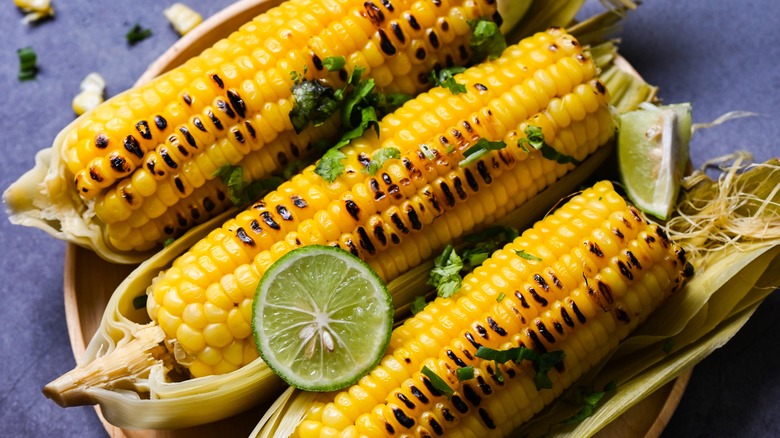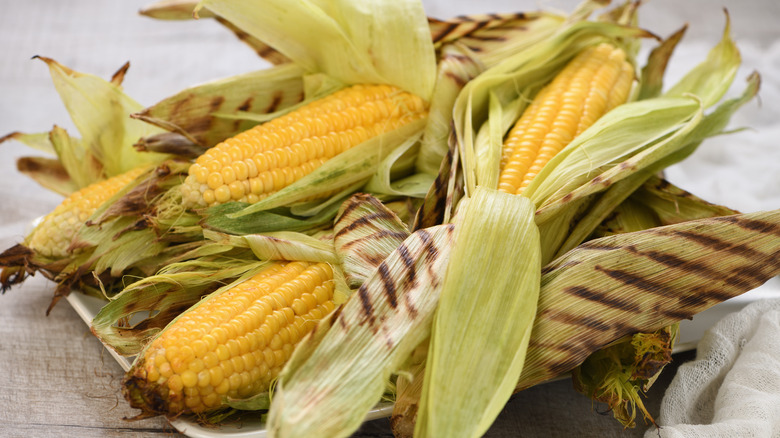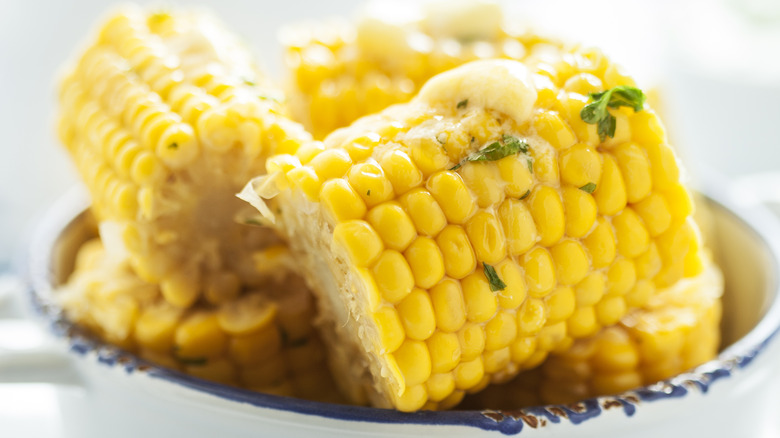How To Bring Out The Sweetness In The Most Mediocre Corn Cobs
In the ideal culinary world, corn cobs get harvested only hours before landing on dinner plates. But in reality, those golden-tasseled cobs in green husky cloaks have a long journey from field to market. As time lapses, so does the sweetness and flavor tucked inside the succulent little kernels.
Before being plucked from the stalk, corn kernels harbor large amounts of natural sweet sugar. However, that sugar rapidly starts converting to starch after the harvest, resulting in bland, stodgy flavor and undesirably dense texture. The cobs also start losing inherent moisture and begin to dry out.
Rest assured, encountering mediocre corn cobs in your kitchen doesn't spell disaster. Bringing out the sweetness in overly starchy corn kernels can be as easy as cooking the ears of corn inside their husks, using a high heat level to help consolidate the lingering amounts of sweetness. Leaving the husks intact is the crucial element in this process.
Extracting sweetness out of that waning corn cob
Perhaps you purchased aging corn at the grocery store or simply forgot about those juicy yellow cobs waiting in the fridge. The freshness decline becomes evident through the fading of the green husks and the browning of silk fibers, or when the kernels start losing their firmness and plumpness. Inspect the exposed ends for any signs of shriveled kernels or dryness. If telltale signs appear, don't chance blandness at the dinner table — just switch up your approach to cooking the corn.
Instead of de-husking the cobs before boiling or grilling, leave them covered in their natural coats as they enter the heat. Husks typically retain some of the corn's original sugar, flavor, and moisture, which potentially soak into the kernels and help prevent dehydration. The husks can also add their own unique earthy taste and fragrance to the corn. Keeping them covered, grill the cobs as you would typically do, using high heat until the husks start showing signs of charring. Just be careful not to overcook. Alternatively, you could place the cobs into your oven, preheated to a temperature between 450 and 500 degrees Fahrenheit, and let them cook for about 30 to 40 minutes.
More options for revitalizing corn
Sometimes, you just have to accept corn the way it is. Perhaps it's out of season or has been harvested too soon. In this case, you may need to add some outside love. One method of sweetening bland corn is to remove the husks and place the cobs in boiling water that's been infused with a small amount of sugar. About 3 to 4 teaspoons of sugar per gallon of water should do the trick. The science behind this involves bitter-tasting prolamin proteins inherent in the corn, which increase as the natural sugars decrease. Your new boiled sugar-water solution intervenes, allowing its sweetness to soak into the kernels, essentially displacing the bitter proteins.
There's also the option of overpowering tasteless corn with yummy additions. Simply slather some butter and salt onto the corn cob, or go all out with homemade buttery spreads. Mother Nature is happy to help out with fresh spices and herbs such as cayenne, chili powder, rosemary, dill, smoked paprika, basil, or lemon thyme. Just mash them into softened butter, and let the mixture melt over warm corn cobs. For ultimate sweetness, you might even want to dribble in some honey. Top with citrus peel, garlic, or sprinkles of Parmesan — whatever strikes your fancy.
It's worth familiarizing yourself with specific types of corn as well. Some hybrids, such as Olathe Sweet corn, naturally contain more sugar, so any loss of sweetness isn't quite as noticeable.



